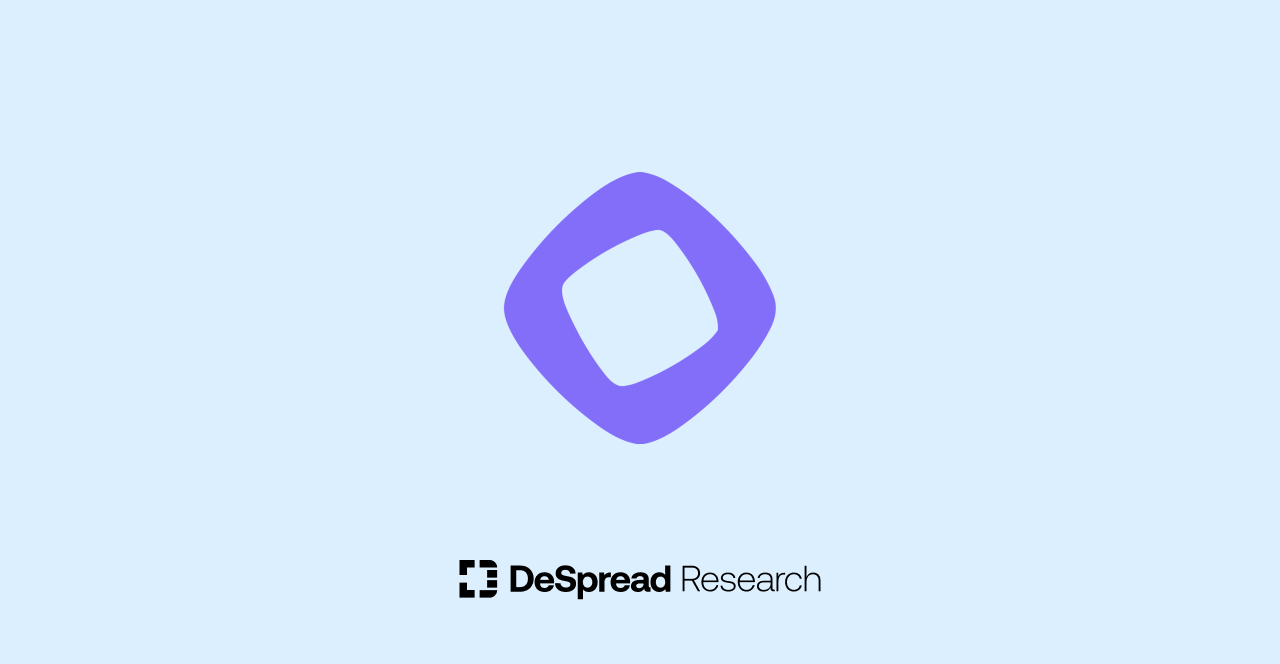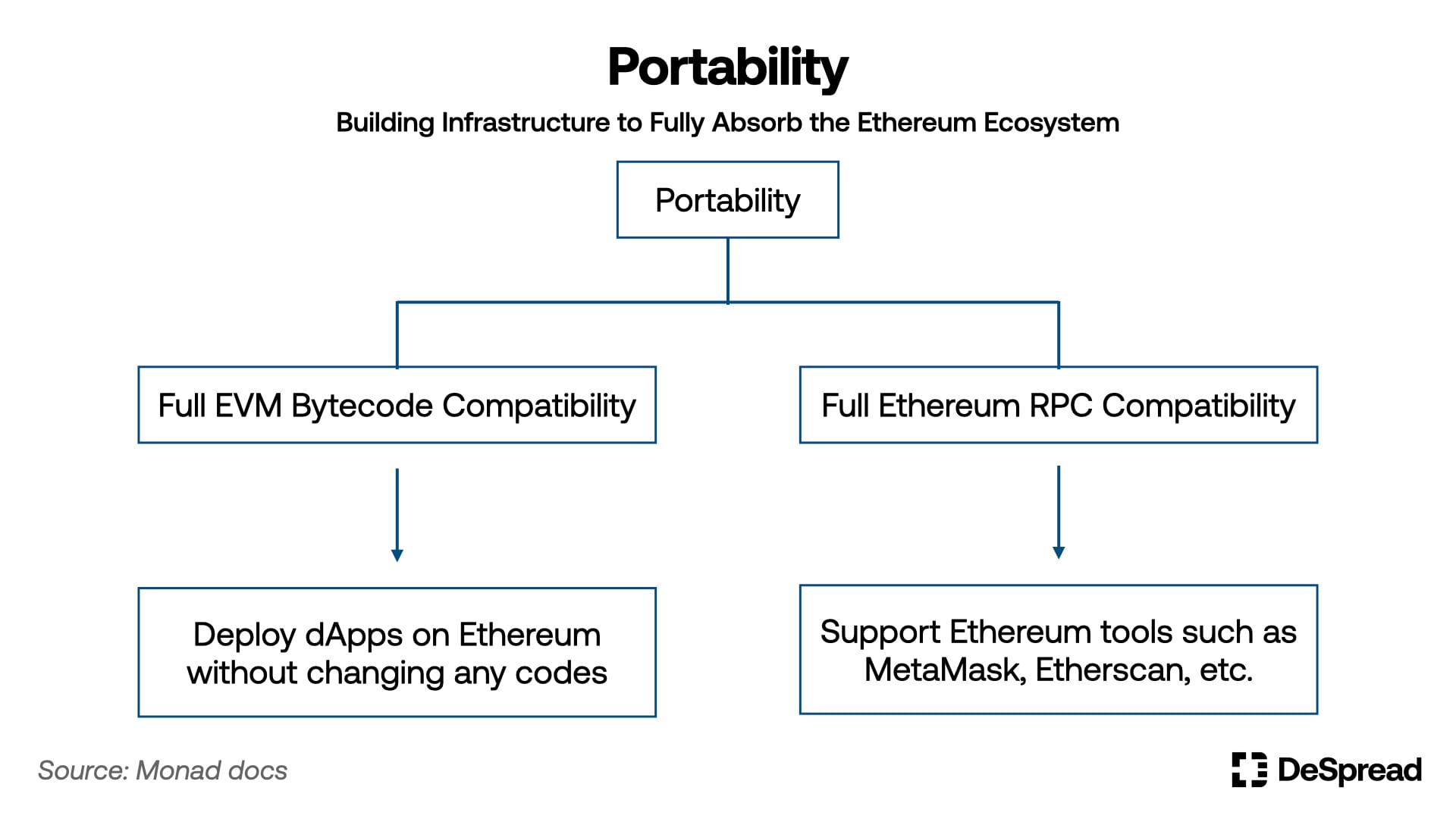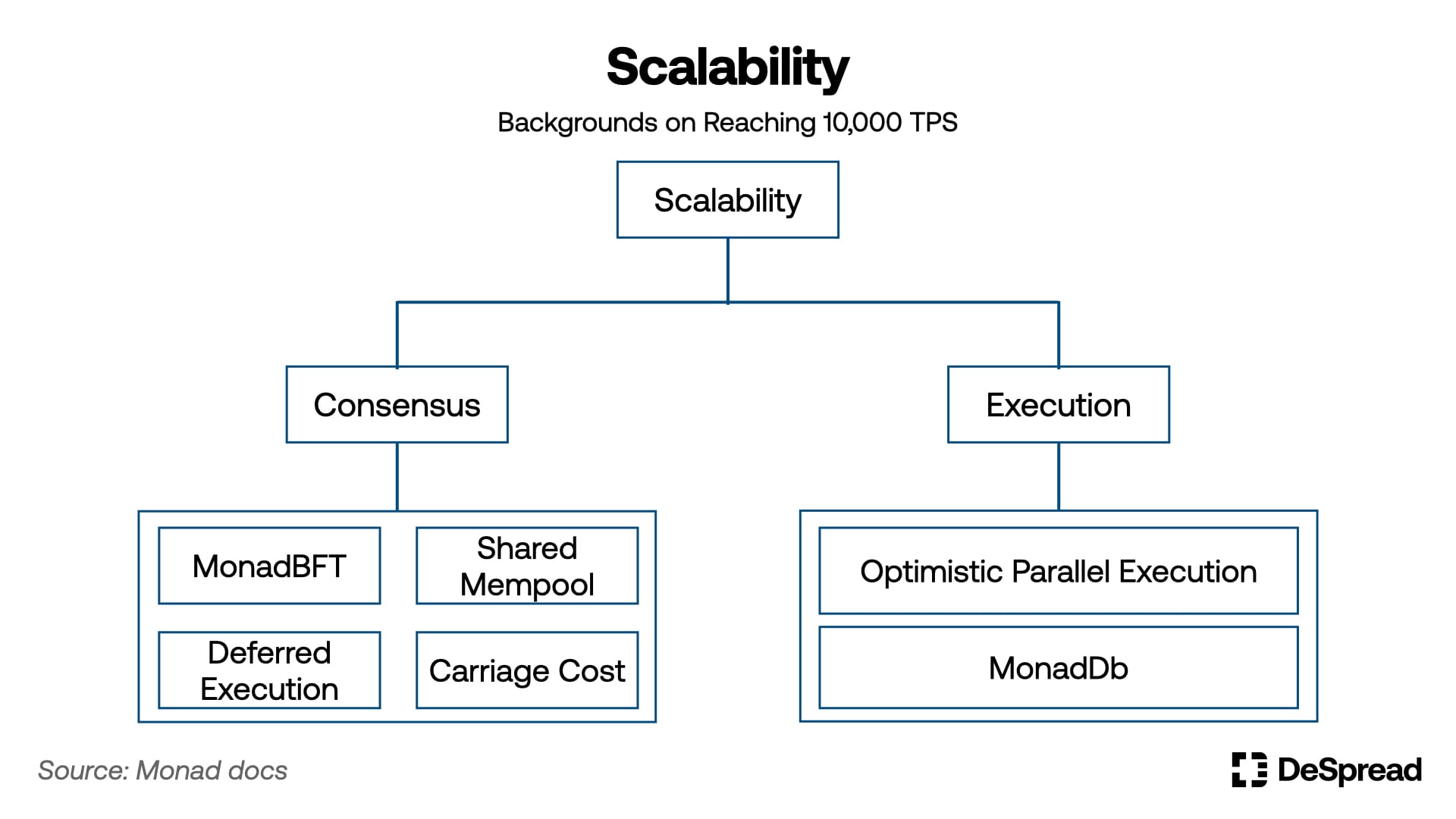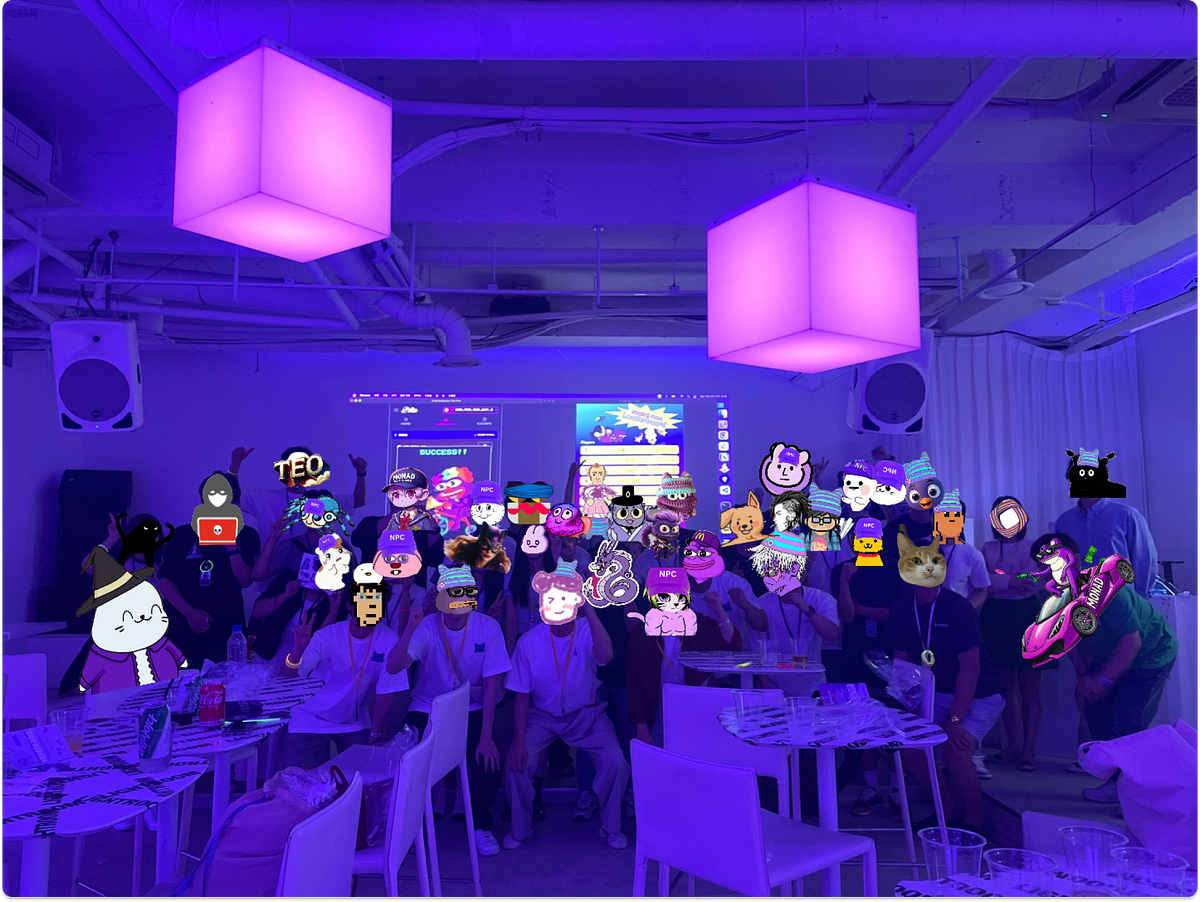
Monad — Introducing a New Paradigm in Community Building
Focusing on the Technology and Marketing Strategy of Monad

1. Introduction
The importance of community in the blockchain industry has been emphasized repeatedly. While communities are often cited as a critical factor that can determine the success or failure of a project, it is rare to find exemplary cases where the community genuinely contributes to the project, fosters strong bonds among its members, and is appropriately recognized and valued by the team.
In today's environment, where new project launches are announced constantly, capturing the attention of a limited pool of market participants and converting them into community members is a challenging first step. Even when a community reaches a certain size, the nature of the market, which is heavily driven by investment, often leads to a rapid decline in community activity if the project's token price drops. These scenarios have been observed frequently in the relatively short history of the blockchain industry.
Amidst these growing challenges of building a meaningful community, a new project has garnered significant attention in the market due to unprecedented community activity, even before the launch of its testnet. This project is Monad, a high-performance Layer 1 blockchain compatible with the Ethereum Virtual Machine (EVM). In this article, we will explore the two pillars that drive Monad: its technology and its community, with a particular focus on how Monad is introducing a new paradigm for communities in the blockchain industry.
2. What is Monad?

Monad's co-founder and CEO, Keone, previously worked in high-frequency trading (HFT) at the well-known proprietary trading and cryptocurrency firm, Jump Trading. During his eight years in traditional finance, Keone observed that blockchains, including Ethereum, struggled to handle the vast scale required by traditional financial systems. For instance, traditional financial systems often execute between 2 to 4 million transactions per day, with nominal trading volumes exceeding $1 trillion. This experience led him to realize that blockchain's limited scalability was a significant barrier to broader adoption. Driven by the desire to bridge the gap between traditional finance and decentralized finance (DeFi), Keone embarked on a mission to create a network capable of processing transactions at the scale of traditional finance by dramatically improving scalability. This vision laid the foundation for the Monad.
As previously mentioned, Monad's primary goal is to enhance scalability through faster transaction processing and lower costs. While several new Layer 1 projects, such as Solana, Aptos, and Sei, have been launched with a focus on scalability, Monad distinguishes itself by offering full Ethereum Virtual Machine (EVM) compatibility. This ensures that Monad can fully support Ethereum's developers and decentralized applications (dApps), effectively positioning itself as a "faster and cheaper Ethereum." By doing so, Monad seeks to differentiate itself from existing Ethereum rollups and other Layer 1 solutions.
3. Monad, Fast and Cheap Ethereum
Now, let's delve into the technical aspects that have garnered Monad significant attention. Two key features stand out: 1) portability enabled by full EVM compatibility, and 2) scalability achieved through Monad's unique consensus and execution architecture.
3.1. Portability: Fully Absorbing Ethereum

Portability refers to the ability to migrate Ethereum dApp smart contracts to Monad without requiring any code modifications. This feature allows Monad to fully integrate with the Ethereum ecosystem, which boasts the largest pool of capital and users in the blockchain industry. Monad achieves this portability through two key components: 1) Full EVM Bytecode Compatibility and 2) Full Ethereum RPC Compatibility.
3.1.1. Full EVM Bytecode Compatibility
Bytecode is the format in which contracts are stored and executed on the Ethereum network by the Ethereum Virtual Machine (EVM). Smart contracts written in the Solidity programming language must be compiled into bytecode before they can be processed by the EVM.
Monad's Full EVM Bytecode Compatibility ensures that any contract deployed on Ethereum can be seamlessly transferred to Monad without requiring any modifications. This compatibility positions Monad to accommodate the approximately 1,100 dApps currently operating on Ethereum. By enabling this easy migration, Monad significantly addresses the challenges that new blockchain ecosystems often face, such as attracting popular dApps and their user bases, thereby enhancing its competitive position in the market.
3.1.2. Full Ethereum RPC Compatibility
Ethereum RPC (Remote Procedure Call) is a protocol used for communication with Ethereum nodes, allowing access to data and the transmission of transactions using the JSON-RPC standard. While full EVM Bytecode Compatibility enables Monad to directly migrate dApps from Ethereum, RPC compatibility ensures that various tools interacting with Ethereum nodes—such as MetaMask, Etherscan, Dune, and Hardhat—can be seamlessly utilized within the Monad ecosystem.
3.2. Scalability: Achieving 10,000 TPS

Scalability refers to a network's ability to facilitate fast transaction processing and maintain low transaction costs. One of the key metrics used to assess a network's scalability is Transactions Per Second (TPS). On March 14, Monad announced via its official Twitter account that it had achieved 10,000 TPS on its devnet. This milestone indicates that Monad has successfully created an environment capable of processing 1 billion transactions per day.
Monad's ability to achieve such high scalability is rooted in its unique consensus and execution mechanisms. In this chapter, we will delve into the core components of Monad's consensus and execution mechanisms that enable this exceptional level of performance.
3.2.1. Consensus
Monad's consensus mechanism is structured around four key components:
- MonadBFT: This is Monad's unique consensus algorithm, which employs a pipelining to handle block proposals, voting, and finality across multiple rounds rather than a single round.
- Shared Mempool: To verify the hash (a unique identifier) of proposed blocks under MonadBFT, Monad uses a system where each node shares its mempool, the storage area for transactions waiting to be validated.
- Deferred Execution: Unlike Ethereum's consensus structure, where consensus on a block requires all nodes to complete transaction execution, Monad separates consensus and execution by making nodes first agree on the order of transactions and then proceed with their execution.
- Carriage Cost & Reserve Balance: This system addresses the potential issue of transaction failures due to insufficient gas fees. When a user submits a transaction, they pay a carriage cost upfront. If the transaction is executed successfully, this cost is refunded. The reserve balance refers to a dedicated balance set aside by each node to cover transaction fees.
Monad's innovative MonadBFT algorithm, which decouples block consensus from execution, is specifically designed to enhance scalability by enabling rapid transaction processing and reducing costs. Each of the four components is crafted to complement and support the others, addressing potential challenges that could arise from focusing solely on scalability. For example, the shared mempool mitigates issues related to nodes only receiving block hashes, while the carriage cost and reserve balance system addresses potential gas fee shortages that could result from deferred execution.
3.2.2. Execution
Monad’s unique execution mechanism revolves around two key elements:
- Optimistic Parallel Execution: This approach enables the parallel processing of transactions in the upcoming block even before the consensus on the previous block is finalized. It operates under the assumption that all operations will be valid. If any errors are detected during the validation stage, the specific transaction is re-executed. Ultimately, the results of all transactions are arranged linearly, similar to Ethereum.
- MonadDb: This custom-built database stores state information and supports asynchronous input/output operations. This feature enables the system to begin processing the next transaction without waiting for the previous transaction's results to be finalized.
Monad’s approach to improving scalability extends beyond pipelining for parallel transaction execution. Recognizing that one of the biggest challenges to EVM scalability is the bottleneck caused by state access, Monad developed its own database, MonadDb, to address this issue. No matter how many threads are utilized for parallel processing, the effectiveness is significantly diminished if they cannot simultaneously access the state data in the database.
4. Community, The Alpha and Omega of the Project
Monad's recent surge in popularity is not solely due to its rapid transaction processing speed but also significantly influenced by the pivotal role of its community. While the importance of community in the blockchain industry has long been emphasized, few projects have successfully mobilized their community members as actively as Monad has, particularly before the launch of their testnet. Monad stands out as a rare example where community engagement has been both recognized and actively practiced, with participation regularly highlighted on the project's official social media accounts and by core foundation members. In this chapter, we will explore the structural uniqueness, core values, and growth background of the Monad community.
4.1. Direction of Monad Community Design
The Monad community is open to everyone, but not all members are treated equally. Among its primary platforms—Twitter, Telegram, and Discord—Twitter serves as the channel for external branding, while Discord and Telegram differentiate the level of access and activities based on members' contributions and duration of participation.
In the early stages of community development, Monad encountered challenges in fostering active participation from its members. This led to the creation of a tiered system where members receive different levels of access based on their contributions. The rationale behind this structure was well articulated in an interview with Keone and Kevin on the Good Game Podcast. When the Monad Discord server was launched in October 2022, all participants were given a "Pioneer Role" to encourage active engagement. However, contrary to expectations, many members who received the role did not remain active. This experience taught Keone and Kevin two important lessons: first, the criteria for role assignment needed to be stricter, and second, it was crucial to encourage a broader range of community activities beyond simple, repetitive tasks.
A significant turning point in shaping the current structure of the Monad community was also the announcement of the first $19 million funding round led by DragonFly Capital in 2023. At that time, the Monad Discord server had a limited number of participants. However, following the announcement, demand for participation surged, prompting Monad to open the Discord server to the public. Instead, Monad utilized private Telegram chat rooms to distinguish existing from new community memebers.
Next, we will examine the structure and characteristics of the Monad communities on Discord and Telegram.
4.2. Structure of the Monad Community
4.2.1. Discord
In the Monad Discord community, members' access to content and the scope of their activities are determined by the roles they hold. This structure incentivizes community members to engage in a wide range of activities to earn higher roles. The anticipation of future rewards, particularly following the Token Generation Event (TGE), further fuels this motivation. Although the Monad Foundation has not made any official announcements regarding role-based rewards, the news that one of Monad's partner projects, Wormhole, rewarded members based on the number of rolls they earned in the airdrops raised expectations that Monad would adopt a similar approach.
Wormhole airdropped 8,000 $W to Monad members with Nads role.
— Henrik (@HWihler) April 7, 2024
That was worth ~$14,000 at launch. As a pipeline intern and member of the OG TG, I know many Nads who have received the airdrop. Some come from countries where this amount of money is extremely high.
NADs on top. pic.twitter.com/smlruV5CML
Activities within the Monad Discord community, such as chatting, completing daily missions, and creating Monad-themed memes, have been ongoing for a significant time, helping to establish a unique identity for the project. Meme characters like Molandak, Moyaki, and Chog, which have become synonymous with Monad, were all created through the spontaneous efforts of community members. The Monad Foundation has embraced these characters, incorporating them into various branding efforts, including the creation of guilds and merchandises.
Below is an overview of the currently identified roles, along with their associated permissions and how they can be obtained:

4.2.2. Telegram Community
While Discord serves as an open community space for everyone, Telegram offers a more private environment reserved for members who have made significant contributions to Monad over an extended period. Currently, there are three active chat groups: the OG Chat, the House of Molandak, and the House of Moyaki (formerly known as Purgeatory).
Access to Monad's Telegram chat groups is granted to members who actively engage in community activities both online and offline. This includes interacting with the community on Twitter and Discord, participating in various Monad offline meetups, and significantly contributing to Monad's branding efforts. Only after demonstrating such commitment can members receive an invitation link to the House of Molandak or Moyaki from a member with invitation privileges or directly from a Monad Foundation member.
Members of the Molandak and Moyaki chat groups are expected to actively participate in ongoing community activities, including weekly missions assigned to each group. Those who excel in these tasks (approximately 10 members from each chat group) are given the opportunity to join the OG Chat each week. However, even within the OG Chat, members are required to continue participating in weekly missions and remain active.
To prevent entering the private chat groups from becoming the ultimate goal, Monad has implemented the "Thursday Purgeday" system across all three Telegram chat groups, including the OG Chat. This system enforces active participation by removing 25 to 50 members every Thursday who have shown minimal engagement. This approach ensures that only the most dedicated members remain in the chat groups, fostering a culture of continuous and enthusiastic participation.
🪓THURSDAY PURGEDAY🪓
— Monad ⨀ (@monad_xyz) July 18, 2024
Right now, members from all 3 Monad TG chats are being purged in parallel
Want an invite? Leave a comment 👇 pic.twitter.com/qfrP5GiiCH
Recently, it was announced that the weekly missions in Monad's private chat groups have been discontinued. This decision reflects the Monad Foundation's recognition of the growing fatigue and dissatisfaction among community members due to the pressure of constant activity. The Foundation now encourages members to contribute to the community at their own pace and discretion. However, the Purgeday remains in place, meaning that the pressure to stay active and engaged is unlikely to be fully alleviated.
4.3. Background of Monad Community Growth
Having explored the history and characteristics of the various channels within the Monad community, this chapter will delve into the strategies that have propelled Monad's community to become one of the most notable in the industry.
4.3.1. Rejecting the Playbook
The term "playbook" refers to a set of standard strategies or rules commonly used in a specific industry to achieve certain goals—essentially serving as a guideline. In the blockchain industry, marketing and community building have traditionally followed a well-established playbook. This often involves promoting a project's strengths through social media posts and using onboarding platforms like Galxe Quest or Layer3 to attract users and followers through simple tasks such as likes, retweets, and quizzes.
While these methods have proven effective in boosting early-stage project metrics like followers, Total Value Locked (TVL), and Daily Active Users (DAU), Monad chose a different path. The project argued that such superficial metrics do not represent an ideal marketing strategy or community development approach. Instead, Monad adopted a novel strategy that diverged from industry norms.
From the outset, Monad's primary goal in community building was not merely to increase numbers. Rather, the focus was on creating a lively and trendy brand image by encouraging community members to engage in humorous and meme-based activities on social media. The aim was to foster a culture where people who encountered these posts would feel a genuine, voluntary desire to join the community.
At the heart of Monad's unique strategy was Kevin, who led the growth efforts at Monad. Widely known on Twitter as "Intern," Kevin introduced a fresh perspective on Web3 marketing. His innovative approach is encapsulated in his post titled "10 Rules for Crypto Marketing & Community: A Systems Approach."
1. Stop posting ads.
2. You are competing with influencers and entertaining content on twitter, not with other protocols.
3. Your marketing & community strategy should take a systems approach.
4. Invest heavily in community.
5. Post and interact with top community content from your main account and from the founders' accounts.
6. Association > Knowledge.
7. Do not blindly copy and paste someone else's strategy.
8. Quality > Quantity.
9. Do things that don't scale.
10. A community is made up of real people with real lives that have other things to do.
Particularly, rules 2 and 6 align closely with the core principles of the Attention Economy, a concept that has become a dominant trend in the advertising landscape of the social media era. The Attention Economy treats human attention as a scarce resource, reflecting a key economic approach in today's industry, where consumer attention directly correlates with a company's value.
Similar to how Nike emphasizes concepts like freedom, boundlessness, and energy over the technical superiority of its sneakers, or how Red Bull highlights the spirit of challenge and pushing beyond limits through extreme sports rather than focusing on the caffeine content of its energy drinks, Monad chose to focus on the humor, freedom, and approachability of its community. Rather than prioritizing the technical superiority of its product or the scale of its investments, Monad effectively communicated its brand image through social media, capturing the interest of Web3 users.
4.3.2. Embracing Web3 Native Culture
Rejecting traditional Web3 marketing strategies, Monad chose to embrace Web3 native culture, particularly through the use of memes. In the early stages of establishing the Monad community’s identity, they adopted a purple-colored version of Pepe the Frog, one of the most iconic memes in the Web3 space. This character, colored in Monad’s signature purple, was widely shared as Telegram stickers and Twitter memes, eventually making purple synonymous with Monad’s identity. As the community evolved, members started creating their own memes, resulting in the birth of characters like Molandak, Moyaki, and Chog. These characters have since become the definitive memes representing Monad.
Monad’s marketing strategy, led by Kevin, focused on humorously conveying the project’s image through memes rather than emphasizing its technical superiority. This approach not only fueled the explosive growth of the Monad community but also introduced a new trend in the Web3 industry with the "Intern" account model. In this model, the "Intern" account operates separately from the official account on social media, using memes to communicate market conditions, project updates, and brand identity in a lighthearted and humorous manner.
Crypto's a dangerous world, fraught with scams, frauds, and unscrupulous characters.
— Pendle Intern (@PendleIntern) July 31, 2024
Here's the Ultimate Opsec Guide that EVERYONE needs to protect your magic internet money 👇🏻
1/69 pic.twitter.com/B0ZWd1TEVq
Monad has taken a proactive approach by recruiting Key Opinion Leaders (KOLs)—individuals with significant influence on social media—into key roles within its marketing, ecosystem, and growth departments. Influencers such as Kevin, Threadguy, Tunez, and Bill have joined the Monad team, where they manage community engagement on social media, enhance branding through meme posting, and collaborate with other projects to expand the ecosystem.
In addition to integrating these influencers, Monad is committed to embedding the values of "Monad-ness" throughout its organization, from the foundation to the community. To achieve this, Monad has been appointing long-term, actively engaged community members as community managers for their respective countries or even recruiting them as team members. This strategy helps maintain a consistent brand identity and fosters a deeper connection between the community and the project, ensuring that the ethos of Monad is shared and upheld at every level.
4.3.3. Building a True Community
Monad’s Community Lead, Bill, believes that the concept of "community" is often misunderstood in the industry. He argues that a true community must be more than just a collection of audiences who follow project updates, users who engage with the product, and contributors who add to the code and branding. According to Bill, a genuine community is defined by the interconnectedness of its members—a space where people actively interact, exchange ideas, and collaboratively create new value, such as memes. This principle guides the direction of the Monad community.

As previously mentioned, most of the memes that now represent Monad were created by the community rather than the foundation. Even today, numerous Monad memes crafted by community members are continuously shared across various social media platforms, such as Discord and Twitter. To foster a sense of unity with the community, the foundation also actively participates in these creative endeavors. One such initiative is the weekly "Memes of the Week" selection, where the foundation highlights and introduces the winning memes and their creators through the official account.
Monad Memes of the Week #45
— Monad ⨀ (@monad_xyz) August 16, 2024
ty: @Hype_Finder, @onekhizzie, @AetheriusEisen, @miami_eth 💜 https://t.co/G7iY45pAwD pic.twitter.com/ngpIdIiG9Q
In addition to meme creation, the Monad community has expanded its creative efforts to include video production, the creation of physical merchandise, and even the release of mixtapes on SoundCloud, all based on Monad memes. Such a broad range of initiatives makes the Monad community accessible and enjoyable for members, even those without specialized knowledge in blockchain or development.
Another example of the spontaneous and active participation within the Monad community is the organization of meetups in various countries, driven entirely by community members. So far, meetups have been held in several countries, including Japan, China, and Thailand. In South Korea, the Seoul meetup, which took place on July 18th, was a notable success.

5. Conclusion
5.1. Challenges Ahead
The active participation and sheer volume of content produced by Monad community members are unprecedented. However, this level of engagement also comes with increasing pressure and workload for members.
As mentioned earlier, the Monad community is structured with distinctions based on members' contributions and their status within the community, reflected in access to Discord channels, differentiated roles, and entry into private Telegram chat groups. Although the foundation has not officially confirmed it, there is speculation that these systems could lead to differentiated rewards for community members when the mainnet is launched.
To secure more roles and belong to more groups, community members must tackle a range of tasks, including daily and weekly missions set by Monad, as well as their regular activities on social media. In doing so, they are expected to showcase their creativity and embody the essence of "Monad-ness." Even after gaining access to the highly competitive Telegram chat groups, members are required to maintain a high level of activity due to the Purgeday system. This increasing workload and pressure are directly proportional to the growth of the Monad community. In fact, it's not uncommon to find former members criticizing the excessive demands and unclear promotion and expulsion criteria within the community.
Furthermore, as many projects have struggled to retain users and capital post-airdrop, the importance of long-term retention has become increasingly evident. For the Monad team, sustaining the current level of community engagement after rewards will likely require a delicate balance between mitigating user fatigue and fostering community growth.
5.2. Monad, Sounding the Alarm in the Industry
Monad has emerged as one of the most talked-about projects in the crypto industry, thanks to its technical superiority, characterized by perfect EVM compatibility and scalability achieved through its unique consensus and execution architecture. Additionally, its innovative approach to community building has further cemented its reputation.
The project has garnered significant attention by introducing unprecedented systems such as private Telegram chat groups, a promotion and demotion system, and community-driven meme creation missions that extend beyond simple tasks. While these strategies have increased pressure on community members and attracted criticism regarding the potential decline in meaningful activities, there is no denying that Monad has underscored the critical importance of community in the blockchain industry and presented a new paradigm for other projects to consider.
As the industry watches closely, key questions remain: Will the Monad community maintain its vibrancy and engagement after the mainnet launch? How will rewards for community members be structured? And to what extent will the Monad ecosystem, with its full EVM compatibility, succeed in absorbing Ethereum’s ecosystem and capital? The answers to these questions will be crucial in determining Monad’s long-term impact and success in the blockchain space.
References
- Monad Docs
- 모나드 한국 공식 블로그
- Cookies' X
- Four Pillars, 내러티브와 기술이 합쳐진 괴물, 모나드
- Tikare Odunlami, Reasons For The Success Of The Monad Community And Its Potential For Growth
- Tunez, Marketing for Monad Native Applications
- Good Game Podcast, 10x Devs & 10x Growth Leads with Monad's Keone and Intern
- DeFlow, Interview with Monad Labs CEO
- Boffin, Memetic Backed Value (MBV): With Head Cultist, Bill of Monad